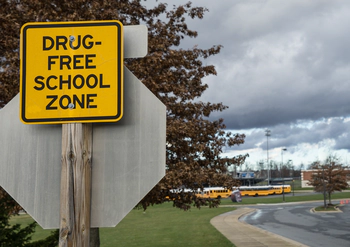Study Finds Adolescents Have a 3X Risk for Developing Cannabis Addiction

The question as to whether or not cannabis is addictive has been debated for years. And while the drug does not cause chemical dependencies or overdose risks as alcohol or opioids do, cumulative research over the years indicates cannabis is habit-forming.
Further, recent data suggests young people are at higher risk of developing severe cannabis addiction, which could lead to unwanted physical, emotional, and behavioral outcomes.
A Recent Study’s Findings
A June 2022 study published in the Journal of Psychopharmacology found that adolescents were at least 3.5 times more vulnerable to developing severe cannabis addiction than adults were. The researchers defined cannabis addiction as a condition that includes:1
- Drug cravings
- Some withdrawal symptoms
- Intending to cut back but not being able to do so
- Interpersonal problems exacerbated by cannabis use
- Cannabis use contributing to failures in school or at the workplace
- Heightened tolerance of the drug and requiring more of it to get high
The researchers found that 50% of teenage cannabis users who participated in the study had six or more cannabis addiction symptoms (six or more symptoms being the threshold for cannabis addiction). No other age group in the study reached the 50% mark. Typically, other age groups had about 9-11% of participants manifesting six or more addiction symptoms.
Is Cannabis Addictive?

The viewpoint that cannabis is not addictive has long been refuted. Addiction is simply an inability to cease engaging in an activity despite the harmful nature of that activity. Cannabis use does not have to look the same as an addiction to heroin for it to be an addiction. Cannabis addiction can manifest as compulsive cannabis use, being unable or unwilling to stop using the drug despite the user experiencing harmful effects from it.
Research from the National Institute on Drug Abuse suggests that 30% of those who use cannabis will develop an addiction to it. NIDA also reports that people who begin using cannabis products before the age of 18 are four to seven times more likely to develop an addiction to cannabis later on in life.2
NIDA also reports that at least four million Americans meet the criteria for cannabis addiction, and about 138,000 seek treatment for their addiction each year. NIDA researchers speculate that one of the reasons why it is now so abundantly clear that marijuana is addictive (and why more Americans are hooked on it than ever before) is because marijuana potency has increased dramatically in recent decades. In the 1990s, the average THC content of confiscated marijuana was less than 4%. But by 2018, confiscated marijuana was almost four times more potent, with an average of 15% THC, sometimes significantly more.
The Importance of Educating Young People on the Harmful Nature of Cannabis
Public health institutions cannot stress enough the importance of educating young people about the risks of cannabis use, education being the best preventative to-date. Case in point, the above study’s lead researchers concluded their findings with a recommendation for schools and parents to inform youths about cannabis harm to dissuade them from experimenting with the drug.
“Our findings suggest that schools should be teaching pupils more about the risk of addiction to cannabis, which has been neglected in drugs education…”

In the words of Professor Val Curran, the study’s lead author, “Our findings suggest that schools should be teaching pupils more about the risk of addiction to cannabis, which has been neglected in drugs education. Becoming addicted to cannabis is a serious problem in itself, but it can also increase the likelihood of other mental health problems. Teenagers should therefore be informed of their greater risk of addiction.” Parents and educators alike can and should combat youth cannabis abuse by showing young people why they would not want to use cannabis.3
Parents and teachers should check in frequently with young people, see how they’re doing, and use informal times (like meal times or in-between classes) to talk about cannabis. They should stick only to the facts when discussing cannabis and help teens configure an ’exit plan’ in the event that peers pressure them to use cannabis. Simply explaining to young people that marijuana can harm brain development and lead to persistent health problems and relationship struggles can be enough to dissuade youths from experimenting with the drug. It’s also worth mentioning that cannabis harms attention span, concentration, problem-solving skills, learning capabilities, and memory retention.4
Youth Cannabis Experimentation and Addiction, Signs and Symptoms to Look For
Whereas the medical and scientific community once debated whether or not cannabis experimentation contained an addictive element, it seems leading institutions across America have reached consensus about the potentially addictive nature of this drug. For example, the Centers for Disease Control and Prevention joined the National Institute on Drug Abuse in publishing information about the addictive nature of cannabis.5
Beyond its addictive nature, cannabis use creates serious health risks. Most significant is the risk for long-term harm in the form of memory loss, cognitive maldevelopment, increased drug use and cravings, and many of the same physical ailments associated with long-term tobacco consumption. Given these risk factors, parents need to know what cannabis experimentation looks like, so they can intervene if they find out their sons or daughters are using the drug.
Some signs and symptoms to look for include:
- Drug-themed clothing, jewelry, or décor
- Bloodshot eyes, having to use eye drops frequently
- Frequent use of cologne, incense, perfume, and other deodorizers
- Trouble in school or the workplace, difficulty holding down a job
- Forgetfulness, poor physical coordination, unusual or untimely laughter
- Unexplained lack of money, always asking for money, suspected of stealing money

- New friend groups, not spending time with old friends, often disappearing for hours at a time
- Strange smelling clothing, room smells odd, and personal possessions have an odd scent to them
- Irritable or unwilling to answer questions about personal life and day-to-day activities and/or peer groups
When parents and teachers notice these signs and others like them, they should take action, find out if their son, daughter, or student is using cannabis, and intervene if so. Parents and teachers must persuade the individual to halt cannabis use as soon as possible. If the person cannot stop using the drug, they should seek help at a qualified drug and alcohol rehab center.
Sources:
-
SAGE. “The CannTeen Study: Cannabis use disorder, depression, anxiety, and psychotic-like symptoms in adolescent and adult cannabis users and age-matched controls.” Journal of Psychopharmacology, 2022. journals.sagepub.com ↩︎
-
NIDA. “Is Marijuana Addictive?” National Institute of Drug Abuse, 2020. nida.nih.gov ↩︎
-
ScienceDaily. “Adolescents more vulnerable to cannabis addiction but not other mental health risks, study finds.” Science Daily, 2022. sciencedaily.com ↩︎
-
SAMHSA. “Talking with Your Teen About Marijuana.” Substance Abuse and Mental Health Services Administration, 2022. samhsa.gov ↩︎
-
CDC. “Marijuana and Public Health.” Centers for Disease Control and Prevention, 2020. cdc.gov ↩︎





 ®
®